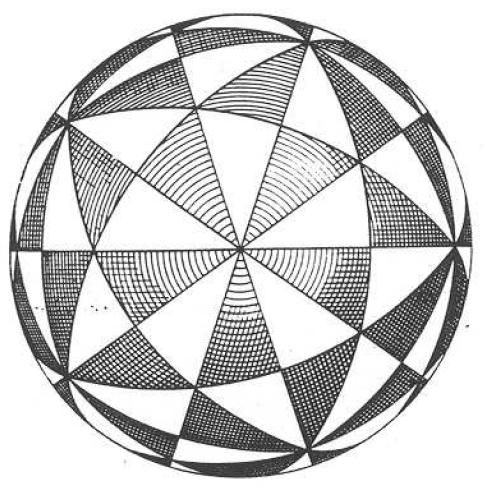Problem - B. Bradie (USA)
Evaluate
\[I=\int_{-1}^1\frac{\text{arccos}(x)}{x^2+x+1}\,\mathrm dx.\]Solution
We show that
\[I=\frac{4\pi^2}{3\sqrt{3}}-\frac{2\pi}{\sqrt{3}}\text{arctan}\left(\sqrt{3+2\sqrt{3}}\right).\]Let $x\mapsto\cos(x)$ so
\[\begin{align*} I &= \int_0^\pi\frac{x\sin(x)}{1+\cos(x)+\cos^2(x)}\,\mathrm dx.\end{align*}\]Now consider the contour integral
\[\begin{align*} \oint_{C_\ell}\frac{z\sin(z)}{1+\cos(z)+\cos^2(z)}\,\mathrm dz\end{align*}\]where $C_\ell$ is the positively oriented rectangular contour connecting the points $-\pi,\,\pi,\,\pi+i\ell,\,-\pi+i\ell$. The integral along the bottom portion ends up being
\[\int_{-\pi}^\pi\frac{x\sin(x)}{1+\cos(x)+\cos^2(x)}\,\mathrm dx=2I,\]and the integrals along the vertical edges may be combined as
\[\begin{align*} \left(\int_\pi^{\pi+i\ell}+\int_{-\pi+i\ell}^{-\pi}\right)\frac{z\sin(z)}{1+\cos(z)+\cos^2(z)}\,\mathrm dz &= \int_0^{i\ell}\frac{(\pi+y)\sin(y)}{1-\cos(y)+\cos^2(y)}\,\mathrm dy \\&\qquad+\int_{i\ell}^0\frac{(-\pi+y)\sin(y)}{1-\cos(y)+\cos^2(y)}\,\mathrm dy \\ &= 2\pi\int_0^{\ell}\frac{\sinh(y)}{1-\cosh(y)+\cosh^2(y)}\,\mathrm dy \\ &= \frac{4\pi}{\sqrt{3}}\arctan\left(\frac{2\cosh(\ell)-1}{\sqrt{3}}\right)-\frac{2\pi^2}{3\sqrt{3}}\end{align*}\]which follows from
\[\begin{align*} 2\pi\int\frac{\sinh(y)}{1-\cosh(y)+\cosh^2(y)}\,\mathrm dy &= 2\pi\int\frac{\sinh(y)}{\left(\cosh(y)-\frac{1}{2}\right)^2+\frac{3}{4}}\,\mathrm dy \\ &= \frac{4\pi}{\sqrt{3}}\int\frac{1}{1+u^2}\,\mathrm du,\,u=\frac{2\cosh(y)-1}{\sqrt{3}} \\ &= \frac{4\pi}{\sqrt{3}}\arctan\left(\frac{2\cosh(y)-1}{\sqrt{3}}\right)+C.\end{align*}\]The integral along the top portion of the contour may be bounded as follows when $\ell$ grows large,
\[\begin{align*} \left|\int_{\pi+i\ell}^{-\pi+i\ell}\frac{z\sin(z)}{1+\cos(z)+\cos^2(z)}\,\mathrm dz\right| &\leq\frac{2\pi\underset{x\in[-\pi,\,\pi]}{\text{max}}|(x+i\ell)\sin(x+i\ell)|}{\underset{x\in[-\pi,\,\pi]}{\text{min}}|1+\cos(x+i\ell)+\cos^2(x+i\ell)|}, \\ &\qquad\text{by the ML lemma} \\ &= \frac{2\pi|(\pi+i\ell)\sin(\pi+i\ell)|}{1+\cosh(\ell)+\cosh^2(\ell)} \\ &< \pi\sqrt{\pi^2+\ell^2}\cdot\frac{\left|e^{i\pi-\ell}\right|+\left|e^{-i\pi+\ell}\right|}{\cosh^2(\ell)} \\ &< 2\pi\sqrt{\pi^2+\ell^2}\cdot\frac{e^\ell}{\frac{e^{2\ell}}{4}+\frac{e^{-2\ell}}{4}+\frac{1}{2}} \\ &< 8\pi\sqrt{\pi^2+\ell^2}\frac{e^\ell}{e^{2\ell}} \\ &< \frac{8\pi\ell}{e^{\ell}},\,\text{when }\ell\geq\pi.\end{align*}\]Putting these results together and taking a limit yields
\[\begin{align} \lim_{\ell\to\infty}\oint_{C_\ell}\frac{z\sin(z)}{1+\cos(z)+\cos^2(z)}\,\mathrm dz &= 2I+\frac{4\pi^2}{3\sqrt{3}}.\tag{1}\end{align}\]Now we will calculate the same contour integral using the residue theorem. For $\ell$ large enough, $C_\ell$ contains simple poles at $z_0=2\text{arctan}(w)$ and $z_1=2\arctan(iw)$ where $w=\sqrt[4]{3}e^{i\pi/4},$
\[\begin{align*} \lim_{\ell\to\infty}\oint_{C_\ell}\frac{z\sin(z)}{1+\cos(z)+\cos^2(z)}\,\mathrm dz &= 2\pi i\sum_{s=z_0,\,z_1}\underset{z=s}{\text{Res}}\,\frac{z\sin(z)}{1+\cos(z)+\cos^2(z)} \\ &= 2\pi i\bigg(\lim_{z\to z_0}\frac{(z-z_0)z\sin(z)}{1+\cos(z)+\cos^2(z)} \\ &\qquad+\lim_{z\to z_1}\frac{(z-z_1)z\sin(z)}{1+\cos(z)+\cos^2(z)}\bigg) \\ &= 2\pi i\bigg(z_0\sin(z_0)\lim_{z\to z_0}\frac{(z-z_0)}{1+\cos(z)+\cos^2(z)} \\ &\qquad+z_1\sin(z_1)\lim_{z\to z_1}\frac{(z-z_1)}{1+\cos(z)+\cos^2(z)}\bigg) \\ &\overset{\text{L}'\text{H}}{=} -2\pi i\bigg(z_0\sin(z_0)\lim_{z\to z_0}\frac{1}{\sin(z)+2\sin(z)\cos(z)} \\ &\qquad+z_1\sin(z_1)\lim_{z\to z_1}\frac{1}{\sin(z)+2\sin(z)\cos(z)}\bigg) \\ &= -2\pi i\left(\frac{z_0}{1+2\cos(z_0)}+\frac{z_1}{1+2\cos(z_1)}\right).\end{align*}\]It would be nice to express this number in a more elegant form. Making use of the identity $\cos(2\arctan(x))=\frac{1-x^2}{1+x^2}$ gives
\[\begin{align*} -2\pi i\left(\frac{z_0}{1+2\cos(z_0)}+\frac{z_1}{1+2\cos(z_1)}\right) &= -2\pi i\left(\frac{z_0(w^2+1)}{3-w^2}-\frac{z_1(w^2-1)}{w^2+3}\right) \\ &= -2\pi i\left(\frac{iz_0}{\sqrt{3}}-\frac{iz_1}{\sqrt{3}}\right) \\ &= \frac{4\pi}{\sqrt{3}}\left(\arctan(w)+\arctan(-iw)\right) \\ &= \frac{4\pi}{\sqrt{3}}\left(\pi+\arctan\left(\frac{(1-i)w}{1+iw^2}\right)\right), \\ &\qquad\text{accounting for the branches of arctan} \\ &= \frac{4\pi}{\sqrt{3}}\left(\pi+\arctan\left(\frac{(i-1)(1+\sqrt{3})w}{2}\right)\right) \\ &= \frac{4\pi^2}{\sqrt{3}}-\frac{4\pi}{\sqrt{3}}\arctan\left(\sqrt{3+2\sqrt{3}}\right).\end{align*}\]The last equality may be verified by seeing that $\frac{(i-1)(1+\sqrt{3})w}{2}$ and $-\sqrt{3+2\sqrt{3}}$ are both the negative solutions to the minimal polynomial $x^4-6x^2-3$.
The result of our residue calculation is
\[\begin{align} \lim_{\ell\to\infty}\oint_{C_\ell}\frac{z\sin(z)}{1+\cos(z)+\cos^2(z)}\,\mathrm dz &= \frac{4\pi^2}{\sqrt{3}}-\frac{4\pi}{\sqrt{3}}\arctan\left(\sqrt{3+2\sqrt{3}}\right).\tag{2}\end{align}\]Equating $(1)$ and $(2)$ gives
\[2I+\frac{4\pi^2}{3\sqrt{3}} = \frac{4\pi^2}{\sqrt{3}}-\frac{4\pi}{\sqrt{3}}\arctan\left(\sqrt{3+2\sqrt{3}}\right)\]or put differently,
\[I=\frac{4\pi^2}{3\sqrt{3}}-\frac{2\pi}{\sqrt{3}}\text{arctan}\left(\sqrt{3+2\sqrt{3}}\right)\]as claimed.
